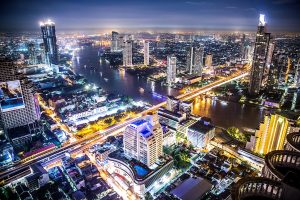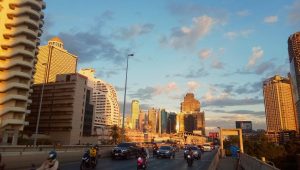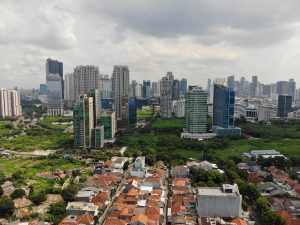44 SE Asia: Population Geography I – Primate Cities
Primate mammals include human beings; however, a primate city, though populated by human beings, is named for mammals, but instead the term refers to the word primary meaning singular and dominant. Thus, a primate city dominates its country in all urban ways.
Four factors should be evaluated to consider whether or not a country is likely to have a primate city. Two of these are crucial measures of population size. First, does the country have a large population? If yes, this decreases the probability that one city dominates the country’s urban population, for a large population provides sufficient numbers of people to populate many large cities.
Second, does the country have a large area? If yes, then this too decreases the probability that one city dominates the country’s urban population, for a large area provides sufficient territory to develop many large cities.
Third, does the country have a long history of urbanization? If yes, then again the probability of a primate city decreases, for there has been enough time for many cities to form and grow in size and importance.
- If a country has none of these three characteristics, then it will not have a primate city.
- If it has one of these three characteristics, then it might have a primate city.
- Two of three, probably a primate city.
- Three of three, nearly guaranteed a primate city.

Let’s consider these factors in regard to Southeast Asia. First, do Southeast Asian countries have large populations? Indonesia certainly does, ranking #4 in the world with 275 million people. The Philippines holds 110 million people, while Vietnam’s population is 100 million. Okay, we may count these three countries as large in population, certainly Indonesia at least. Cambodia 15 million, Laos 7.5 million, East Timor 1.3 million – these are small countries.
Second, do Southeast Asian countries have large areas? Again, Indonesia is the largest country in the region, this time by area at 580 thousand square miles. For comparison, this is about the area of Alaska. Myanmar, at 261 thousand square miles, is second in the region, comparing to Texas. Otherwise, we have some rather small countries – Singapore, by definition as a city-State, along with Brunei and East Timor are specks on the map.
Third, does Southeast Asia have a long history of urbanization? Given that urbanization is associated with industrialization and that Europe is the birthplace of industrialization, we can assert that Southeast Asia does not have a long history of urbanization. In fact, overall Southeast Asia is only 50% urban. Singapore, as a trading city of long renown, may be the best example of Southeast Asian urban progress.

Photo by Arthur Fedde.
After assessing these characteristics that cause primate cities to arise, we make another check, this is the fourth factor, to determine if the primate city is present. Does the largest city have significant percentage of the country’s urban population? A reasonable threshold would be 15% of the country’s urban dwellers living in just one city and dwarfing any other city.
While these are the noted national characteristics; primate cities themselves are typified by other elements. Primate cities are the political capital cities. Primate cities are the cultural foci of their respective countries. The economic center of the country is the primate city. The primate city dominates the country’s urban life in all ways.
First, here is a table that lists the largest city for each of the countries in SE Asia. Population is expressed in millions of people. City population is measured as the municipal population, not the metropolitan population that may be much larger.
| Country | Population | % Urban | Urban Population | Biggest City | City Population | % of all Urban |
|---|---|---|---|---|---|---|
| Brunei | 0.5 | 78 | 0.39 | BSB | 0.1 | 25.6 |
| Cambodia | 15.7 | 24 | 3.76 | Phnom Penh | 1.5 | 39.8 |
| Indonesia | 275.1 | 55 | 151.30 | Jakarta | 10.1 | 6.7 |
| Laos | 7.5 | 36 | 2.7 | Vientiane | 0.82 | 30.4 |
| Malaysia | 32.8 | 76 | 24.92 | Kuala Lumpur | 1.7 | 6.8 |
| Myanmar | 55.5 | 30 | 16.65 | Yangon | 5.2 | 31.2 |
| Philippines | 110.2 | 47 | 51.79 | Manila | 13.4 | 25.9 |
| Singapore | 5.7 | 100 | 5.7 | Singapore | 5.7 | 100.0 |
| Thailand | 66.7 | 59 | 3.93 | Bangkok | 10.4 | 26.4 |
| Timor-Leste | 1.3 | 31 | 0.40 | Dili | 0.22 | 54.6 |
| Vietnam | 100.2 | 37 | 37.07 | Ho Chi Minh City | 8.99 | 24.2 |
Here we see clear examples of one city having a major share of the country’s urban population. Singapore is our standout case, though that is by definition, for as a city-State it is 100% urban and 100% of the country. Go ahead and use the table to sort the data by the column showing percentage of the country’s urban population that resides in that one city. Not counting Singapore, we observe that the two tiny countries of SE Asia has disproportionate shares of their respective national urban populations in single cities. In Timor-Leste (East Timor), Dili has over half of the country’s urban dwellers. In Brunei, Bandar Seri Begawan (BSB) has some 25% of the urban population of the whole country. It is not really surprising that the capital city dominates the country.
As we consider, small but not tiny countries, by area and by population, again we note examples of cities having big shares of their respective countries’ urban populations. In Cambodia, Phnom Penh has a big 40% of the urban residents there. Even the large population of the Philippines is heavily segmented into its capital city Manila – over one quarter of urban residents are there. Two countries do not qualify – Malaysia and Indonesia. The answer for Indonesia is quite clear, for it has an enormous population of 275 million. In order to reach to 20% threshold, the Jakarta municipality would need to have over 30 million people.
Second, this table compares the largest city to the second largest city for each country. Population is expressed in millions of people.
| Country | Biggest City | City Population | 2nd Biggest City | Population | #1 X bigger #2 |
|---|---|---|---|---|---|
| Brunei | BSB | 0.1 | Kuala Belait | 0.004 | 25 |
| Cambodia | Phnom Penh | 1.5 | Siem Reap | 0.25 | 6.0 |
| Indonesia | Jakarta | 10.1 | Surabaya | 2.7 | 3.7 |
| Laos | Vientiane | 0.82 | Savannakhet | 0.12 | 6.8 |
| Malaysia | Kuala Lumpur | 1.7 | Seberang Perai | 0.82 | 2.1 |
| Myanmar | Yangon | 5.2 | Mandalay | 1.2 | 4.3 |
| Philippines | Manila | 13.4 | Quezon City | 2.9 | 4.6 |
| Singapore | Singapore | 5.7 | none | na | na |
| Thailand | Bangkok | 10.4 | Nonthaburi City | 0.25 | 41 |
| Timor-Leste | Dili | 0.22 | Maliana | 0.02 | 11 |
| Vietnam | Ho Chi Minh City | 8.99 | Hanoi | 8 | 1.1 |
Primate cities are expected to dominate in all urban ways, including being multiples larger than the second ranked city. Let’s sort this table by the “times bigger” column, looking for the largest city to be at least four times more populated than the second largest city. All the cities qualify except in the countries of Indonesia, Malaysia, and Vietnam. Again, Jakarta fails the test for the primate city – okay, got it.
So, what about Malaysia? Does Malaysia feature our listed characteristics – small area, small population, and short history of urbanization? Yes. We expect that Malaysia would have a primate city. According to Table 1, Kuala Lumpur only hold 6.8% of Malaysia’s urban residents, evidently well short of our stated 20% threshold. This is puzzling, for our rules suggest that Malaysia would have a primate city.
Vietnam comes up short in the comparison of #1 and #2 cities. Primate cities are supposed to dominate #2 cities, yet Ho Chi Minh City is only slightly more populated than Hanoi. In this case, however, there is an obvious answer. From 1955 to 1975, this country was split in two – North Vietnam and South Vietnam. Each country had its own main city – North Vietnam had Hanoi, while South Vietnam had Saigon. The two cities developed separately during those years. After the Vietnam War ended, the country was reunited and Saigon was renamed for the North’s communist leader Ho Chi Minh. Both cities continued their development, so that neither became a true primate city.
Overall, we are left with Malaysia and Indonesia not fitting our model. Here, though, I offer a solution by changing terminology and thus the numbers. What is we measure by metropolitan area and not by municipality or city? Would this make a difference? Wow, look at the next table, a remake of our first table!
| Country | Population | % Urban | Urban Population | Biggest Metro Area | Metro Population | % of all Urban |
|---|---|---|---|---|---|---|
| Brunei | 0.5 | 78 | 0.39 | BSB | 0.28 | 71.8 |
| Cambodia | 15.7 | 24 | 3.76 | Phnom Penh | 2.2 | 58.4 |
| Indonesia | 275.1 | 55 | 151.30 | Jakarta | 34.5 | 22.8 |
| Laos | 7.5 | 36 | .270 | Vientiane | 0.95 | 35.2 |
| Malaysia | 32.8 | 76 | 24.92 | Kuala Lumpur | 7.6 | 30.5 |
| Myanmar | 55.5 | 30 | 16.65 | Yangon | 7.4 | 44.4 |
| Philippines | 110.2 | 47 | 51.79 | Manila | 24.25 | 46.8 |
| Singapore | 5.7 | 100 | 5.7 | Singapore | 5.7 | 100.0 |
| Thailand | 66.7 | 59 | 3.93 | Bangkok | 15.6 | 39.6 |
| Timor-Leste | 1.3 | 31 | 0.40 | Dili | 0.23 | 57.1 |
| Vietnam | 100.2 | 37 | 37.07 | Ho Chi Minh City | 10.4 | 28.1 |
Notice that the percentage of national urban population in one city increases throughout, as it should be definition. Yet, for Kuala Lumpur and for Jakarta, the numbers surge upwards. Kuala Lumpur’s metropolitan area has 30% of Malaysia’s urban dwellers, whereas it had less than 7% as a municipality. Jakarta has an astonishing 34.5 million people in its metro area, some 22% of Indonesia’s urban residents.

Now we can assert that SE Asia does indeed feature the primate city, or should we say, the primate metro. Hmm, “primate city” has a better ring to it. But yes, by measuring with the category of metropolitan area, it is clear that each SE Asian country is dominated by a single city, except for the case of Vietnam, as we note its historical geography.
Did you know?
Cited and additional bibliography:
Fedde, Arthur. Bangkok Traffic. Photo.
Jarvis, Braden. Bangkok. Unsplash.” Photo. 9 July 2018. https://unsplash.com/photos/Q2gcswjLhS8.
Kusuma, Afif. Jakarta. Unsplash. Photo. 20 May 2019. https://unsplash.com/photos/bYwiAUGM1zU.

